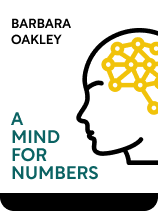

This article is an excerpt from the Shortform book guide to "A Mind for Numbers" by Barbara Oakley. Shortform has the world's best summaries and analyses of books you should be reading.
Like this article? Sign up for a free trial here .
How does your brain work? What’s the difference between focused thinking and diffuse thinking?
A key theme of the book A Mind for Numbers is that alternating between modes of thinking (focused thinking and diffuse thinking) can help you learn new things and problem-solve effectively. To understand how to do this and why it works, you first need to understand a few things about how your brain works.
Keep reading to learn about the two modes of thinking.
The Two Basic Modes of Thinking
Author Barbara Oakley explains that your brain naturally alternates between two modes of thinking: focused and diffuse.
As an analogy for these two modes of thinking, imagine a camera with a variable lens. If you zoom in on the subject, details are clearly visible, but the surroundings are cut off: This is like focused thinking. If you zoom out, the big picture comes into view, but details are obscured: This is like diffuse thinking.
Oakley notes that in nature, animals must alternate between detail-oriented tasks, such as eating berries off a bush (focused mode), and general awareness, such as scanning their environment for predators (diffuse mode). She suggests that this could explain the origin of the two modes.
(Shortform note: This may be an original insight on Oakley’s part. The concept of these two thinking modes was probably first recognized by Edward de Bono, but it appears he studied the modes without delving into their evolutionary origins. Other researchers have suggested that the different functions of the left and right brain hemispheres provide an evolutionary advantage for balancing general awareness with specific tasks. However, Oakley might be the first to connect this concept to the origin of the two thinking modes.)
Based on Oakley’s exposition, let’s compare the two modes in terms of when they are triggered, how they operate in your brain, why you would use them, and the limitations of each that make it necessary to use both.
Focused Thinking
When: According to Oakley, focused thinking occurs when you focus your attention on something.
How: Focused-mode thinking is associated more with the left hemisphere of the brain than the right (although both are involved), with elevated activity in the prefrontal cortex (the part of your brain just under your forehead). Oakley explains that in focused mode, your thoughts progress rapidly along short pathways between concepts that are closely connected in your mind. The more these pathways are used, the more developed they become, and the more quickly and easily your thoughts traverse them.
Why: Focused-mode thinking allows you to take in detailed information or solve simple problems immediately by applying the steps of a solution method that you are familiar with.
Limitations: Oakley notes that focused thinking is susceptible to the “Einstellung effect,” which occurs when you are unable to solve a problem because the solution is outside the range of ideas where you are looking for it.
(Shortform note: “Einstellung” is a German word that Abraham Luchins used to describe this effect in 1942. The German word does not have an exact English synonym. In this context, it could be translated as “setting” (you get set in your ways) or “stopping” (you get stuck or stop making progress).)
For example, imagine that upon returning to your dorm room one day, you find that your roommate has bolted your car keys to a large, heavy object, and welded the nut onto the bolt. How do you get your keys back? Unless you are already familiar with this puzzle or prank from shop class, you will probably only be able to come up with brute-force solutions by focused-mode thinking: You think you’ll need a bolt cutter to retrieve your keys.
However, there is an easier solution: The bolt that your friend used is already cut in the middle, inside the nut. All you have to do is unscrew the bottom half of the bolt from the top half. However, the Einstellung effect may prevent you from recognizing this upfront.
Diffuse Thinking
When: According to Oakley, diffuse thinking happens whenever focused mode-thinking is not happening, such as when you relax or just let your mind wander.
How: Diffuse-mode thinking is associated more with the right hemisphere of the brain than the left (although both are involved), and with a resting state, where activity is not significantly elevated in any particular area of the brain. Oakley explains that during diffuse-mode thinking, your thoughts traverse longer neural pathways between more diverse concepts.
(Shortform note: Researchers such as Raichle have identified a “default mode network”(DMN) in the brain that activates whenever it goes into a resting state. This DMN is where diffuse-mode operates. The DMN runs throughout the major structures of the brain and is not localized to any one part.)
Why: Diffuse thinking continues to subconsciously process information from previous focused-mode thinking but in a different way. It can generate creative ideas and creative solutions to difficult problems, circumventing the Einstellung effect by allowing you to mentally step away from detailed problems and see the big picture.
Oakley points out that this is particularly useful in math and science because creativity and problem-solving are closely related: You can often approach a problem in a variety of ways, but a certain approach may offer advantages for a certain problem. Thinking up alternative solutions can help you find the best method of solving the problem.
Limitation: Oakley also notes that once you devise a creative solution with diffuse mode, you still have to switch to focused mode to carry out the solution, because diffuse thinking doesn’t process information in enough detail for full implementation. Furthermore, to keep the diffuse mode working on a given problem, you have to keep the problem in your mind by periodically revisiting it with focused-mode thinking.
| Perspectives on the Two Modes of Thinking Other writers have used a variety of terms for what Oakley calls “focused-mode thinking” and “diffuse-mode thinking.” Edward de Bono Edward de Bono coined the terms “Lateral Thinking” and “Vertical Thinking” for what Oakley calls diffuse mode and focused mode, respectively. According to de Bono, lateral thinking is a mechanism for generating new possibilities, while vertical thinking is a mechanism for analyzing possibilities and selecting between them. Thus, Oakley’s emphasis on using diffuse mode to generate creative solutions is consistent with de Bono’s presentation, as is her description of the analytical nature of focused mode. However, there is a subtle difference in how they distinguish between the two modes: To Oakley, the distinction is the difference between focusing on something and letting your mind wander. To de Bono, it’s the difference between creatively generating new possibilities and analytically eliminating possibilities. Malcolm Gladwell Malcolm Gladwell contrasted “conscious thinking” with “unconscious thinking” in Blink. Gladwell presents “conscious thinking” as a tool for rational decision-making. He points out that it follows a logical path: We can retrace our thought process if we need to explain our reasoning. He also points out that it is easily disrupted in stressful situations. These characteristics tend to imply that it requires focused attention. Thus, Gladwell’s “conscious thinking” closely resembles Oakley’s focused mode. Gladwell presents a different application for unconscious thinking than Oakley does for diffuse mode: While Oakley recommends using diffuse mode to generate a solution to a technical problem by taking a break from focusing on the problem, Gladwell recommends using unconscious thinking to make assessments and decisions quickly. He presents it as a tool for intuitive decision-making. He also emphasizes that unconscious thinking operates quickly, automatically sorts through sensory information to pick out what’s relevant in the big picture, and follows a “mysterious” path in the sense that we can’t consciously retrace it. The common threads that tie Oakley’s diffuse mode to Gladwell’s unconscious thinking are that they both involve stepping back from the details to see the big picture and they both operate unconsciously. Daniel Kahneman Daniel Kahneman wrote about “System 1” and “System 2” thinking in Thinking, Fast and Slow. He defined “System 1” essentially the same as Gladwell defined “unconscious thinking.” He then defined “System 2” as a conscious, rational, analytical mode of thinking that operates on the intuitive insights and suggestions generated by System 1. According to Kahneman, System 2 can either accept these insights, reject them, or further analyze them. He also states that System 2 has limited capacity, and any task that requires mental energy uses up some of this capacity. Thus, Kahneman’s System 1 is similar to Oakley’s diffuse mode, and Kahneman’s System 2 is similar to Oakley’s focused mode. Kahneman’s description and application of thinking systems is more like Gladwell’s, but from almost the opposite perspective: Gladwell acknowledges that biases can introduce errors in unconscious thinking, but he points out that unconscious thinking can also be remarkably accurate. As such, he teaches you how to take advantage of it. Kahneman acknowledges System 1 as a natural and necessary mental function, but he focuses on the many types of biases that can cause System 1 to be wrong. As such, he teaches you to recognize System 1’s vulnerabilities and use System 2 to compensate for them. Although the types of bias that Kahneman describes are less applicable to technical problems, this theme resonates with Oakley’s observation that once you identify a possible solution with diffuse mode, you still have to switch back to focused mode to work out the details and make sure the solution actually works. |

———End of Preview———
Like what you just read? Read the rest of the world's best book summary and analysis of Barbara Oakley's "A Mind for Numbers" at Shortform .
Here's what you'll find in our full A Mind for Numbers summary :
- How to make math and science intuitive
- Strategies for remembering complex concepts more easily
- How to build good study habits and avoid procrastination






